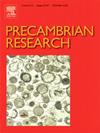Revisiting Oaxaquia-Laurentia connections during Rodinia assembly: Insights from u-pb dating and geochemistry of massif-type anorthosite intrusions and associated rocks from the northern Oaxacan Complex, southern Mexico
IF 3.2
2区 地球科学
Q2 GEOSCIENCES, MULTIDISCIPLINARY
引用次数: 0
Abstract
Oaxaquia is a fundamental piece of the Mexican geological record. This Proterozoic crustal block evolved throughout the Calymmian-Tonian and has been traditionally included within the Rodinian realm. However, several aspects, such as its paleoposition and the occurrence of AMCG magmatism during the final stages of Rodinia’s consolidation, are still a matter of debate. In this work, we present new whole-rock geochemical and LA-ICP-MS U-Pb zircon geochronological data for the Huitzo suite from the northern Oaxacan Complex, one of the most extensive outcrops of AMCG rocks in Oaxaquia. This information allowed us to reinterpret the tectonic evolution of Oaxaquia during the Stenian-Tonian interval and refine its role in the amalgamation process of Rodinia. The massif-type anorthosite intrusions under study are alkalic, Ba-Sr-rich, devoid of olivine, and exhibit antiperthitic feldspars. These features resemble several anorthosite complexes exposed in present-d ay southeastern Laurentia. The U-Pb geochronological data demonstrate the existence of AMCG pulses between 1015–960 Ma that are contemporary to the late- to post-orogenic Laurentian anorthositic-granitic activity. These new insights suggest a space–time relationship between Oaxaquia and Laurentia that challenges the traditional Amazonia-Oaxaquia-Baltica link. We propose that Oaxaquia was caught in the collision zone between Laurentia and Amazonia as Rodinia was being assembled. During this process, Oaxaquia was positioned near the easternmost part of the Grenville Province, a region with a similar magmatic and metamorphic history. This area experienced orogenic relaxation and magmatism associated with lithospheric delamination after the main orogenic phase (∼1020 Ma), thus generating the oldest alkalic anorthosite intrusions along the core of the orogen. Once the collisional orogenesis ended (∼978 Ma), a post-orogenic extensional regime was established, favoring the generation of the youngest AMCG intrusions.
求助全文
约1分钟内获得全文
求助全文
来源期刊

Precambrian Research
地学-地球科学综合
CiteScore
7.20
自引率
28.90%
发文量
325
审稿时长
12 months
期刊介绍:
Precambrian Research publishes studies on all aspects of the early stages of the composition, structure and evolution of the Earth and its planetary neighbours. With a focus on process-oriented and comparative studies, it covers, but is not restricted to, subjects such as:
(1) Chemical, biological, biochemical and cosmochemical evolution; the origin of life; the evolution of the oceans and atmosphere; the early fossil record; palaeobiology;
(2) Geochronology and isotope and elemental geochemistry;
(3) Precambrian mineral deposits;
(4) Geophysical aspects of the early Earth and Precambrian terrains;
(5) Nature, formation and evolution of the Precambrian lithosphere and mantle including magmatic, depositional, metamorphic and tectonic processes.
In addition, the editors particularly welcome integrated process-oriented studies that involve a combination of the above fields and comparative studies that demonstrate the effect of Precambrian evolution on Phanerozoic earth system processes.
Regional and localised studies of Precambrian phenomena are considered appropriate only when the detail and quality allow illustration of a wider process, or when significant gaps in basic knowledge of a particular area can be filled.
 求助内容:
求助内容: 应助结果提醒方式:
应助结果提醒方式:


